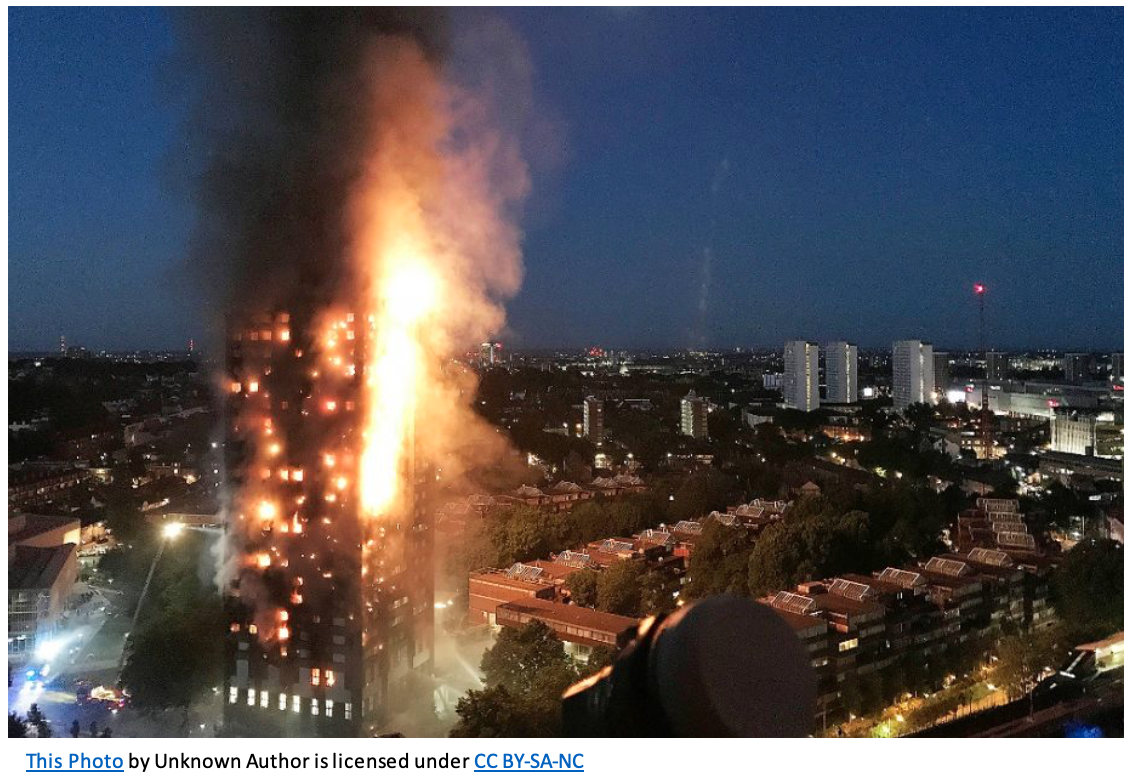 “On 14 June 2017, a fire broke out in the 24-storey Grenfell Tower block of flats in North Kensington, West London, it caused 72 deaths, including those of two victims who later died in hospital. More than 70 others were injured, and 223 people escaped. It was the deadliest structural fire in the United Kingdom since the 1988 Piper Alpha disaster and the worst UK residential fire since the Second World War.
“On 14 June 2017, a fire broke out in the 24-storey Grenfell Tower block of flats in North Kensington, West London, it caused 72 deaths, including those of two victims who later died in hospital. More than 70 others were injured, and 223 people escaped. It was the deadliest structural fire in the United Kingdom since the 1988 Piper Alpha disaster and the worst UK residential fire since the Second World War.
The fire was started by a malfunctioning fridge-freezer on the fourth floor. It spread rapidly up the building’s exterior, bringing fire and smoke to all the residential floors. This was due to the building’s cladding, the external insulation and the air gap between which enabled the stack effect. The fire burned for about 60 hours before finally being extinguished. More than 250 London Fire Brigade firefighters and 70 fire engines were involved from stations across London in efforts to control the fire and rescue residents. More than 100 London Ambulance Service crews on at least 20 ambulances attended, joined by specialist paramedics from the Ambulance Service’s Hazardous Area Response Team. The Metropolitan Police and London’s Air Ambulance also assisted the rescue effort.”
 The Grenfell Tower Inquiry began on 14 September 2017 to investigate the causes of the fire and other related issues. Findings from the first report of the inquiry were released in October 2019 and addressed the events of the night. It affirmed that the building’s exterior did not comply with regulations and was the central reason why the fire spread, and that the fire service were too late in advising residents to evacuate. A second phase to investigate the broader causes began on the third anniversary in 2020.
The Grenfell Tower Inquiry began on 14 September 2017 to investigate the causes of the fire and other related issues. Findings from the first report of the inquiry were released in October 2019 and addressed the events of the night. It affirmed that the building’s exterior did not comply with regulations and was the central reason why the fire spread, and that the fire service were too late in advising residents to evacuate. A second phase to investigate the broader causes began on the third anniversary in 2020.
As of June 2020, the fire is currently being investigated by the police, a public inquiry, and coroner’s inquests. Among the issues being investigated are the management of the building by the Kensington and Chelsea London Borough Council and Kensington and Chelsea TMO (or KCTMO, which was responsible for the borough’s council housing) and the responses of the Fire Brigade, the council and other government agencies. In the aftermath of the fire, the council’s leader, deputy leader and chief executive resigned, and the council took direct control of council housing from the KCTMO. The national government commissioned an independent review of building regulations and fire safety, which published a report in May 2018. Across the UK and in some other countries, local governments have investigated other tower blocks to find others that have similar cladding. Efforts to replace the cladding on these buildings are ongoing.”
(The text above was reproduced from Wikipedia)
Time to ask whether inquiries are fit for purpose
The COVID19 era demands that we review and prioritise everything according to its societal value and this includes close examination of the instruments and processes of governance and management which are the principal root causes of organisational underperformance and failure. It is timely and legitimate for society to seek better, quicker, and cheaper improvement processes and question why we are still ritualistically conducting cycles of costly protracted official inquiries that deliver essentially the same recommendations regarding effective prospect and risk governance and management. E.g. when was the last inquiry that did not say there was a problem with the culture. We do not need protracted and costly judge led inquiries to keep rediscovering already existing expert knowledge and avoidably continually re-exposing those tragically involved depriving them of much needed closure. Governments of whatever persuasion just need to ensure the existing expert knowledge is systematically and competently applied everywhere it is relevant.
Non-application of existing major hazard industry knowledge
The UK Grenfell Tower tragic fire, which is now three years past, had many familiar root causes like other tragic events that have punctuated our history. Our understanding of major hazard governance and management is now highly advanced following many years of analysis of major loss events. The development and accumulation of such knowledge has been painful, and it would no doubt be a societal sin to fail to apply it wherever it can safeguard human life and other assets. The Grenfell Tower inquiry is unlikely to add to this knowledge apart from acting as another example of governance and management failing to implement that knowledge. Most of our major hazard industries in the United Kingdom now rigorously and systematically apply this expert knowledge within fit for purpose regulatory and licensing arrangements, but somehow general major hazard infrastructure capable of killing large numbers of people in a single event and/or destroying valuable infrastructure and has escaped effective risk control.
Poor value of the Grenfell Tower Inquiry
Given the tardiness of the Grenfell Tower Inquiry to complete its investigations and deliver a report, which even then is likely to restate the timeless wisdom of effective risk governance and management, it is right to ask whether ‘an independent enquiry into inquiries’ is needed examining their poor performance? This would identify not only the root causes of underperforming post event inquiries and investigations but the motivations for initiating them in the first place. After decades of official independent judge led inquiries, can they be more than just a political expedient to kick issues into the long grass? What stakeholder benefits, if any, can accrue and does the process of realisation compared with alternative improvement processes represent stakeholder value for money? It should also look at the uniqueness and relevance of the recommendations – has there ever been an enquiry that did not list the culture as being a root cause. Afterall, the reasons for organisational failure and accident causation are now very well understood.
Multiple shames
The protracted conduct of the Grenfell tower fire enquiry surely compounds the initial shame that circumstances were tolerated allowing it to happen. Why was not investigating the root causes of the event and preventing re-occurrence made the top priority and why couldn’t the enquiry have been split into pre-event and post-event sub enquiries and conducted concurrently? When will we acknowledge that inquiries and investigations are projects and need competent project management skills and the application of project risk principles? Would it be better if professionals other than judges led enquiries into major loss events with broader competences to expedite improvement, preventive actions, and societal learning? This would not preclude legal and other experts from participating in the inquiry processes.
A different major infrastructure perspective needed
From the first sight of the flames traversing up the side of the Grenfell Tower viewed on our televisions in real-time, it was obvious that a major hazard event was taking place, many people appeared to be in great danger, and something had seriously failed for it to be happening. Since the fire occurred over three years ago, there has been considerable debate and dialogue about preventing a reoccurrence of the tragedy with many well-intentioned suggestions and others serving narrower interests. However, if we accept that the creation and maintenance of infrastructure capable of killing large numbers of people in a single event is a major hazard industry, all that is needed is to simply acknowledge it and manage it like any other major hazard industry. We simply need to transfer the proven knowledge, expertise, and regulatory methodologies from the established major hazard industries. This includes fully integrated management systems without boundaries, proportionate infrastructure hazard classification, the graded application of risk control, the establishment of approved expert peer reviewed safety cases, where appropriate ‘defence-in-depth’, and life-cycle responsibility and accountability etc. Governance and management should be conducted utilizing a fully integrated management system complying with a universal management system standard such as MSS1000 integrating prospect and risk management. All this could be encapsulated in a single simple inquiry recommendation without further delay.
Infrastructure planning should equitably balance stakeholder needs
The additional costs of proper regulation and licensing should be factored into planning decisions, just as we do in other major hazard endeavours. This helps ensure that the needs, expectations, and aspirations of stakeholders are equitably satisfied while making the best use of resources – the foundation principle of integrated management. This point in human history demands that we achieve more using less resource by sharply focusing on what delivers the most value. Those who by desire or of necessity make their homes or work or participate in leisure pursuits in major hazard infrastructure deserve no less.
Bio Ian Dalling
Ian Dalling is the Director of ‘Unified Management Solutions’, that specialises in integrated approaches to quality and risk management. He is a Chartered Mechanical and Electrical Engineer, a fellow of the Chartered Quality Institute, a fellow of the International Institute of Safety and Risk Management and holds degrees in engineering and physics. He is a retired management consultant and chair of the Integrated Management Community.
Ian’s career commenced in 1962 working for the Central Electricity Generating Board in various posts within nuclear power plants embracing operations, planning, management services, quality management. In 1989 he moved to the United Kingdom Atomic Energy Authority Safety and Reliability Directorate (SRD) as a risk management analyst and consultant.
His career has spanned the design, construction, commissioning, operation, and decommissioning of conventional and nuclear power plants, as well as providing a wide range of quality/risk management consultancy in other major hazard industries including oil and gas, electrical power distribution, rail, construction and medical devices. He started his own management consultancy in 1999 delivering services for clients in the UK and internationally in Eastern Europe, India, and China for national and international bodies. He chaired the Chartered Quality Institute Integrated Management Special Interest Group from 2007 until 2020 when it was expanded into the Integrated Management Community. Ian led the international team that created the world’s first universal management system standard without boundaries (MSS1000). He has published many integrated management papers and articles.
His roles have included:
- Leading operational planning team during the construction and commissioning of an Advanced Gas Cooled Reactor nuclear power plant.
- European Notified Body Quality Manager certifying machinery and medical devices under European Product Directives.
- Serving on the European Process Safety Committee, and the British Standards steering committee for BS 8800, a guide on the management of occupational health and safety.
- Leading a team assessing the 120-year decommissioning programme for the Winfrith Steam Generating Heavy Water Reactor in the UK.
- Assessing nuclear weapons assembly and maintenance safety culture.
- Developing crisis and emergency plans for a regional electricity company.
- Member of international team that assessed the safety of the Lithuanian Ignalina RBMK nuclear power plant following the Chernobyl accident.
- Providing systems analyst support during the development of safety critical software.